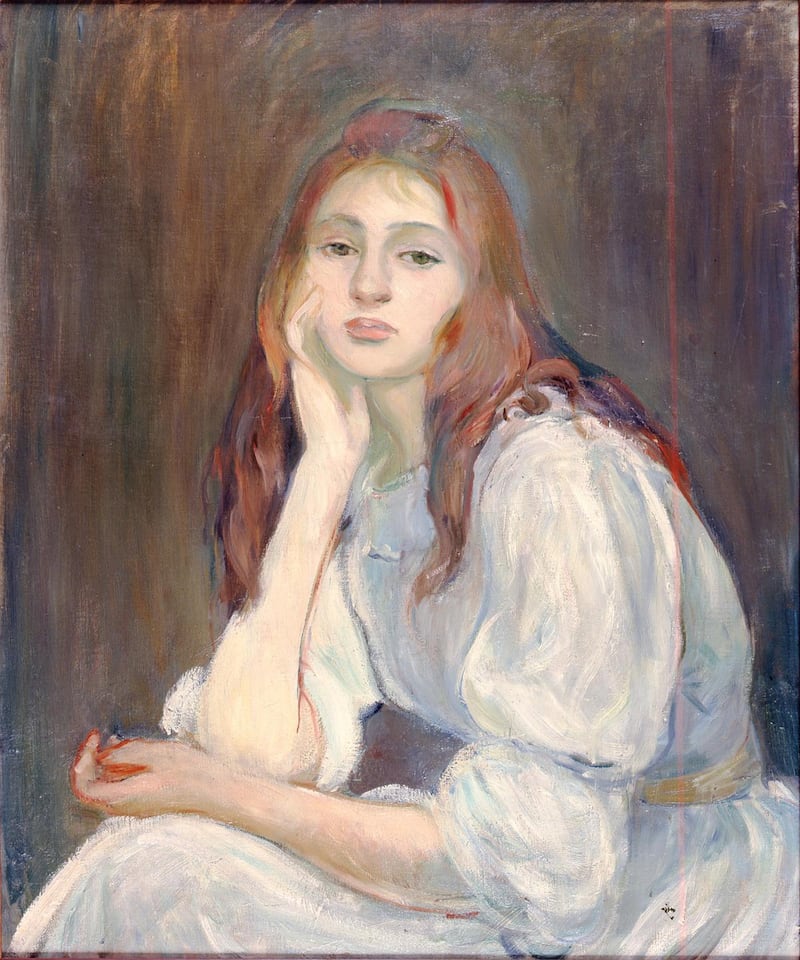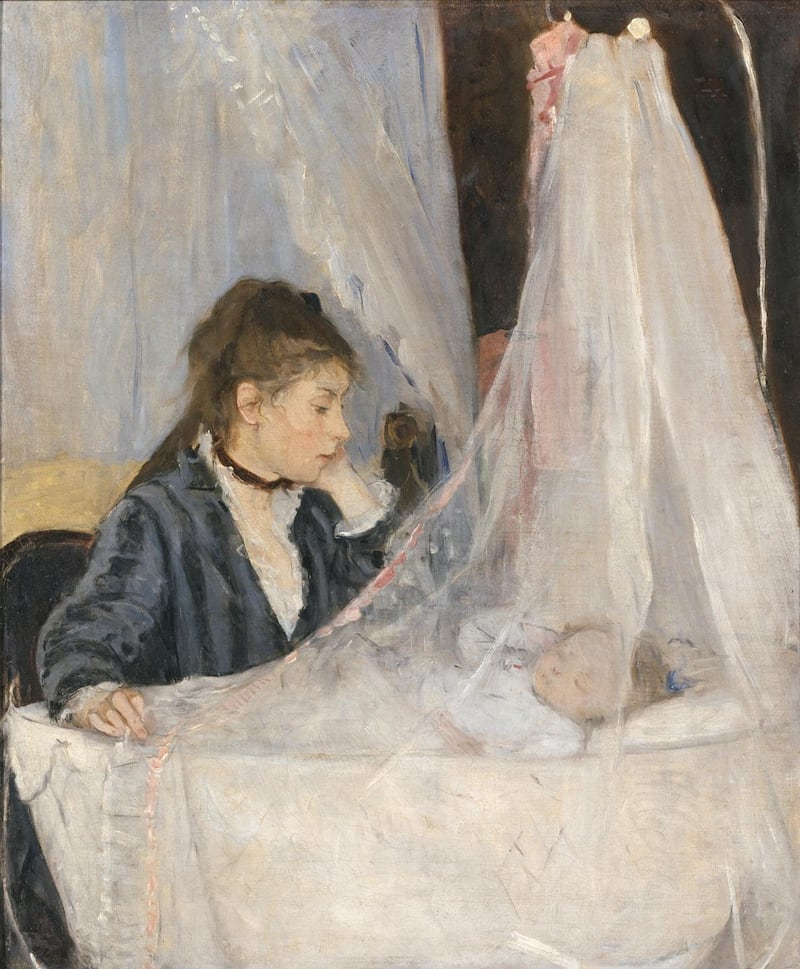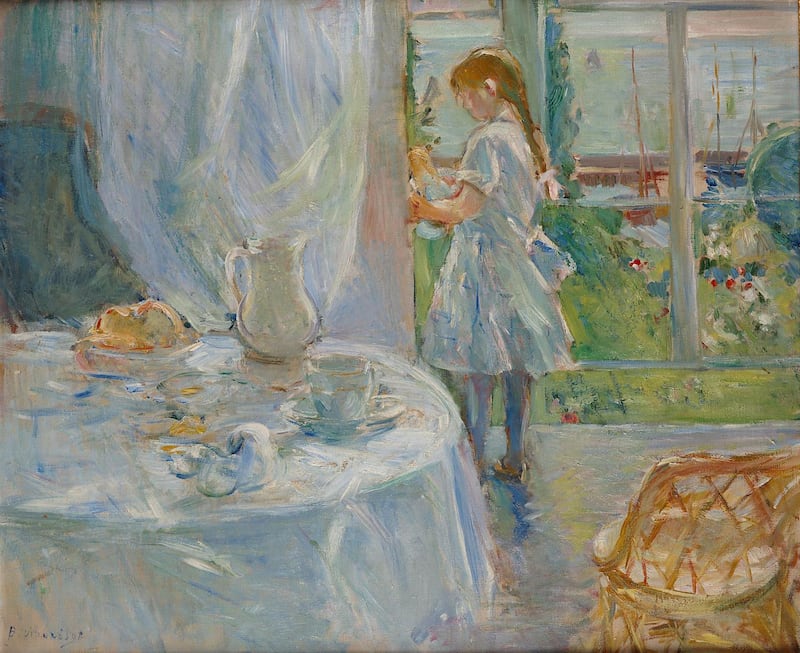There is nothing new about creative women being slighted by male-dominated institutions. But in recent decades, there developed a tendency to exaggerate the achievements of female painters and writers, as over-compensation for the discrimination they endured. Such tokenism becomes a disservice when it implies that a woman like Berthe Morisot (1841-1895), who deserves fame in her own right, is recognised because she was a woman.
Berthe Morisot: Woman Impressionist is at the Barnes Foundation in Philadelphia until January 14th. It will then move to the Dallas Museum of Art from February 24th until May 26th, and to the Musée d'Orsay in Paris from June 18th until September 22nd.
If one wanted to find fault with an otherwise splendid exhibition, it would be over the tendency to miscast Morisot as a feminist icon. Morisot was a leading impressionist, full stop. She contributed 10 paintings to the group's first exhibition in 1874 and missed only one of their shows, after her daughter Julie's birth in 1879. "Her canvasses are the only ones painted by a woman that one could not destroy without leaving a blank, a hiatus in the history of art," the Irish author George Moore wrote after Morisot's death.
Morisot's parents indulged her artistic ambitions, paying for lessons with the best teachers, including the Barbizon painter Jean-Baptiste-Camille Corot
Morisot was, like Monet and Renoir, a quintessential impressionist who painted everyday life, often out of doors. She was obsessed with the play of light and colours, worked in rapid, sketch-like brushstrokes and often left canvasses unfinished. She enjoyed commercial and critical success in her lifetime. And if her fame flagged at times, the same can be said of her contemporaries.
Though Morisot faced greater obstacles than her male colleagues, that a well-educated daughter of a wealthy family achieved success as a painter in the late 19th century was less extraordinary than the fact that such a revolutionary movement in art sprang from the conformist Parisian “grande bourgeoisie”.
The curators of the exhibition state their feminist theme at the outset. “I don’t think there has ever been a man who treated a woman as an equal, and that’s all I would have asked for – I know I am worth as much as they are,” says a quote from Morisot’s diary, in large print on the introductory panel.

Artistic ambitions
Morisot’s parents indulged her artistic ambitions, paying for lessons with the best teachers, including the Barbizon painter Jean-Baptiste-Camille Corot, and building an artists’ studio for Berthe and her sister Edma in the garden of the family home in the fashionable Paris district of Passy.
The year after Morisot’s death, her friends Degas, Monet and Renoir worked with her daughter to organise a retrospective of nearly 400 of her works. She was not a victim of sexism.
But like many male artists, Morisot was plagued by self-doubt and a quest for perfection. “I have never seen you choose something that is within your reach,” her mother Marie-Cornélie wrote to Morisot in 1867. As a young woman, Morisot destroyed many of her own paintings. “She was a suffering, wounded soul that no compliment nor degree of success could reassure,” her great grandson, the academician Jean-Marie Rouart wrote in the catalogue to the Musée Marmottan’s 2012 exhibition.
Morisot’s palette was permanently influenced by Corot’s shimmery, silvery lavender-blues and greens. Corot thought Edma the more gifted of the sisters. Edma’s 1865 portrait of Berthe at her easel proves she had great potential. To Berthe’s chagrin, Edma renounced painting to marry a naval officer in 1869.
The Cradle, Morisot's best known painting, shows Edma gazing at her newborn daughter in 1872. The curators of the exhibition suggest the look on Edma's face "hints at a more nuanced view of motherhood." Yet Berthe later wrote to Edma of her despair at failing to become pregnant following her own marriage. She eventually became a devoted mother.
Morisot painted her daughter countless times, for example as a child contemplating her doll in Cottage Interior, during a family holiday in the Channel Islands, and at age 16 in Julie Dreaming.

Influenza
While caring for Julie, Morisot contracted influenza, which deteriorated into fatal pneumonia. “You never caused me pain in your little life,” Morisot wrote to Julie on her deathbed. “You have looks and money. Use them well.” Morisot asked the poet Stéphane Mallarmé to be her orphaned daughter’s guardian, and her friends Degas, Monet and Renoir to be Julie’s advisers.
Perhaps out of fear of diminishing Morisot's importance, the exhibition barely alludes to her role as a muse to Édouard Manet. He played a fundamental role in Berthe's life, painting her 14 times and introducing her to the painters of the impressionist movement. Two of Manet's paintings of Berthe, The Balcony and Berthe Morisot with a Bouquet of Violets are world famous.
Morisot's sad temperament may have been the result of frustrated love for the married Édouard Manet. "His face is decidedly charming and pleases me immensely," Berthe wrote to Edma after meeting Édouard at the salon in 1869. She was consumed by jealousy when Manet painted his student Eva Gonzales. (That portrait alternates between Dublin's Hugh Lane Gallery and the National Gallery in London.)
If they were not so exquisite, one might label Morisot's most successful paintings as 'frou-frou'
There are hints, but not proof, of a love affair between Édouard and Berthe. "One must burn love letters," Morisot told her friend Louise Riesener.
Manet praised Morisot's painting of The Harbor at Lorient so effusively that Morisot gave it to him. After his death, she purchased Berthe Morisot with a Bouquet of Violets at auction. In her diary, Julie wrote that on the day it was painted "my Uncle Édouard told Maman she should marry Papa and talked to her about it for a long time."
Berthe was 32, an old maid by the standards of the time, when she married Édouard’s younger brother, Eugène. Édouard was a witness at their wedding. They chose him as godfather to their daughter. “I have sinned, I have suffered, I have atoned for it,” Morisot wrote after both brothers died. The three are buried together in the Manet family crypt in Passy.
Eugène promised to make Morisot "the most adored and pampered woman on earth." An amateur painter and novelist, Eugène abandoned his career to devote himself to his wife. He organised her exhibitions and helped raise their daughter. Eugène was also the only man Morisot painted. In England (Eugène Manet on the Isle of Wight), painted during their honeymoon, reversed traditional roles, with Eugène, a man, staring out the window of their rental cottage. Later paintings by Morisot show Eugène playing with Julie.

Feminism
As Sylvie Patry of the Musée d'Orsay, co-curator of the exhibition, points out, the feminist movement started in France around 1880. "The ideas of 'sisterhood' and organised collective struggle seem to have been quite alien to Morisot," Patry writes. Morisot wrote "no profession" on her marriage certificate. The same mention appears on her death certificate. Yet she continued to sign paintings with her maiden name.
If they were not so exquisite, one might label Morisot's most successful paintings as "frou-frou". They include Woman at her Toilette and Reclining Woman in Grey. The critic Charles Ephrussi (who appears at length in Edmund de Waal's The Hare with Amber Eyes), praised Morisot's paintings of women in evening dress, saying, "She crushes on her palette the petals of flowers, to spread them haphazardly on her canvas in witty brushstrokes, full of the breath of life . . . they end up producing something delicate, lively and charming, which one guesses at more than one sees it."
In her youth, Morisot delighted Degas at Manet's mother's weekly salon with her pink silk shoes. She prided herself on her slim figure, to the point of anorexia. She was ravishing in a ruffled black evening gown and gloves, as photographed by Charles Reutlinger.
By contrast, Morisot’s 1885 self-portrait is guileless. At the age of 44, Morisot looks calmly at the viewer, holding her palette and brushes. She wears a black scarf knotted casually around the neck, and her greying hair is pulled back into a simple ponytail. Mallarmé said the flowers on her jacket were like military decorations.
This is Morisot grieving for Édouard Manet, who died in 1883. She is matronly and prematurely ageing, with a large, sagging bosom. "The face has lost its grace, the oval is less perfect," writes Morisot's French biographer, Dominique Bona. But love and a taste for work "are not lost with the years," Morisot wrote to her friend, the US painter Mary Cassatt. "It helps us to accept the wrinkles and white hair."











